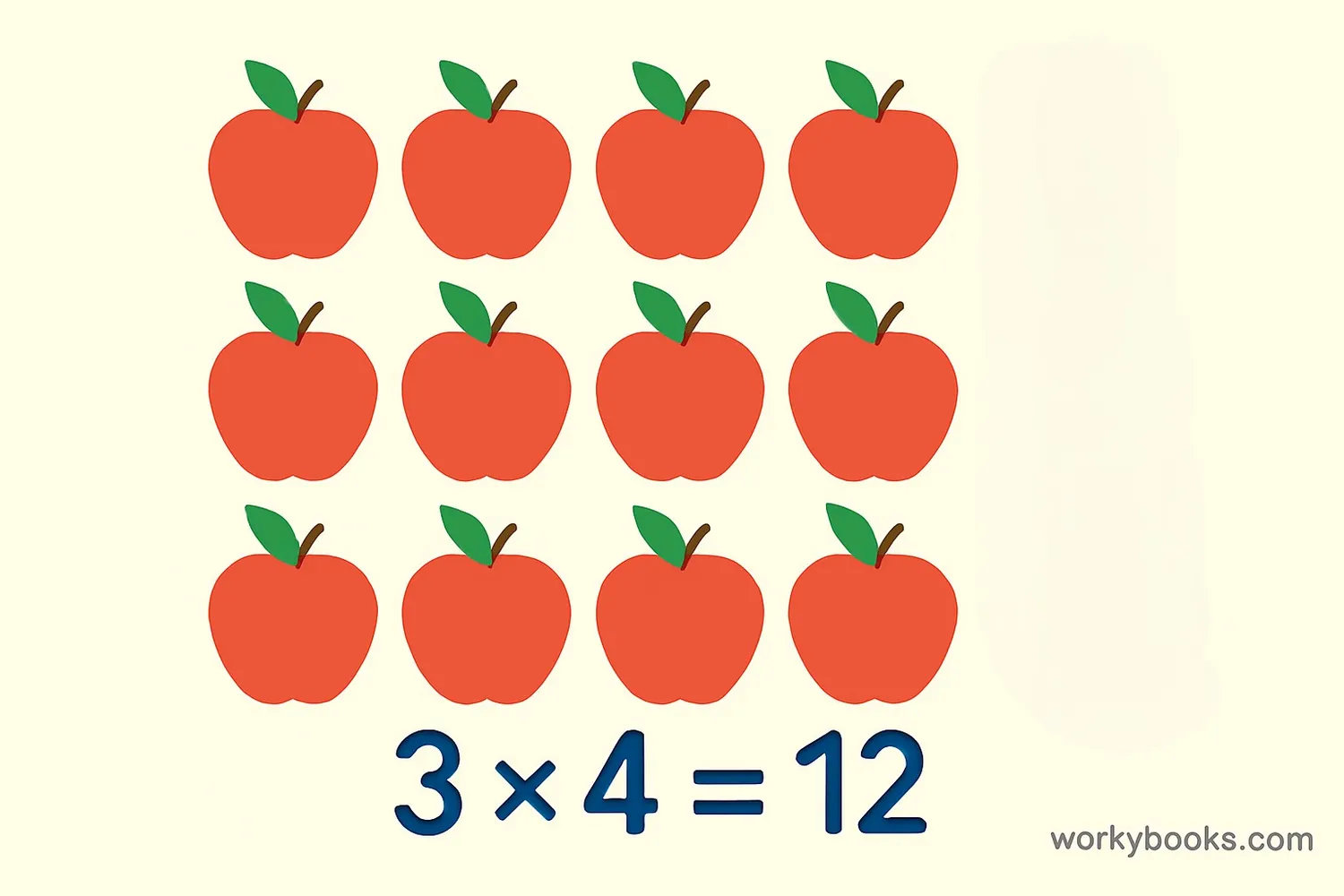Multiplication - Definition, Examples, Quiz, FAQ, Trivia
Learn to multiply numbers with easy explanations, visual examples, and practice activities
What is Multiplication?

Multiplication is a way of adding the same number many times. It's a basic math operation that helps us count things faster. When we multiply, we combine equal groups to find the total.
The × symbol means "multiplied by" or "times." In multiplication, we have:
Factors - the numbers being multiplied
Product - the answer we get after multiplying
For example, in 4 × 3 = 12, the factors are 4 and 3, and the product is 12.
Key Concept
Multiplication is repeated addition. 4 × 3 means 4 groups of 3, or 3 + 3 + 3 + 3 = 12.
Multiplication as Repeated Addition
The easiest way to understand multiplication is as repeated addition. When we see 5 × 3, it means we're adding the number 3 five times:
Multiplication Formula
Five groups of three equals fifteen
Example: Sarah has 4 bags with 5 marbles in each bag. How many marbles does she have?
Step 1: This is 4 groups of 5 marbles → 4 × 5
Step 2: Add 5 four times → 5 + 5 + 5 + 5
Step 3: Calculate the result → 20 marbles
So 4 × 5 = 20. Sarah has 20 marbles.
Remember
Multiplication is a faster way to do repeated addition. The order of numbers doesn't change the product: 3 × 4 = 4 × 3 = 12.
Multiplication Properties
Multiplication has special rules called properties that always work:
Commutative Property
The order of numbers doesn't change the product: 3 × 4 = 4 × 3 = 12
Associative Property
How we group numbers doesn't change the product: (2 × 3) × 4 = 2 × (3 × 4) = 24
Distributive Property
We can break apart a multiplication problem: 6 × 7 = (6 × 5) + (6 × 2) = 30 + 12 = 42
Identity Property
Any number multiplied by 1 stays the same: 8 × 1 = 8
Zero Property
Any number multiplied by 0 equals 0: 9 × 0 = 0
Properties Tip
These properties help make multiplication easier. Use the commutative property to rearrange problems in ways that are simpler to solve!
Multiplication Times Tables
Multiplication tables (or times tables) help us remember basic multiplication facts. Knowing these by heart makes math much easier!
Multiplication Table (1-10)
| × | 1 | 2 | 3 | 4 | 5 | 6 | 7 | 8 | 9 | 10 |
|---|---|---|---|---|---|---|---|---|---|---|
| 1 | 1 | 2 | 3 | 4 | 5 | 6 | 7 | 8 | 9 | 10 |
| 2 | 2 | 4 | 6 | 8 | 10 | 12 | 14 | 16 | 18 | 20 |
| 3 | 3 | 6 | 9 | 12 | 15 | 18 | 21 | 24 | 27 | 30 |
| 4 | 4 | 8 | 12 | 16 | 20 | 24 | 28 | 32 | 36 | 40 |
| 5 | 5 | 10 | 15 | 20 | 25 | 30 | 35 | 40 | 45 | 50 |
| 6 | 6 | 12 | 18 | 24 | 30 | 36 | 42 | 48 | 54 | 60 |
| 7 | 7 | 14 | 21 | 28 | 35 | 42 | 49 | 56 | 63 | 70 |
| 8 | 8 | 16 | 24 | 32 | 40 | 48 | 56 | 64 | 72 | 80 |
| 9 | 9 | 18 | 27 | 36 | 45 | 54 | 63 | 72 | 81 | 90 |
| 10 | 10 | 20 | 30 | 40 | 50 | 60 | 70 | 80 | 90 | 100 |
Table Tip
Notice the patterns in the multiplication table! For example, all products in the 5× table end with either 0 or 5.
Multiplication Practice Quiz
Test your multiplication skills with this 5-question quiz. Choose the correct answer for each question.
Frequently Asked Questions
Here are answers to common questions about multiplication:
Math Trivia
Discover interesting facts about multiplication and mathematics:
Ancient Multiplication
The oldest known multiplication tables were used by the Babylonians about 4000 years ago! They used a base-60 number system (instead of our base-10 system), which is why we have 60 seconds in a minute and 60 minutes in an hour.
Multiplication in Nature
Many patterns in nature use multiplication. Sunflower seeds grow in spirals that follow multiplication patterns (Fibonacci sequence). Pinecones, pineapples, and some flowers also show mathematical patterns based on multiplication.
Large Numbers
Astronomers use multiplication with very large numbers. The distance from Earth to the Sun is about 149 million kilometers. That's 149,000,000 km, or 1.49 × 10⁸ km in scientific notation, which uses multiplication by powers of 10.
Multiplication Records
The world record for reciting the most multiplication facts in one minute is 140 problems, set in 2019! The recorder correctly answered 140 single-digit multiplication problems in just 60 seconds.





